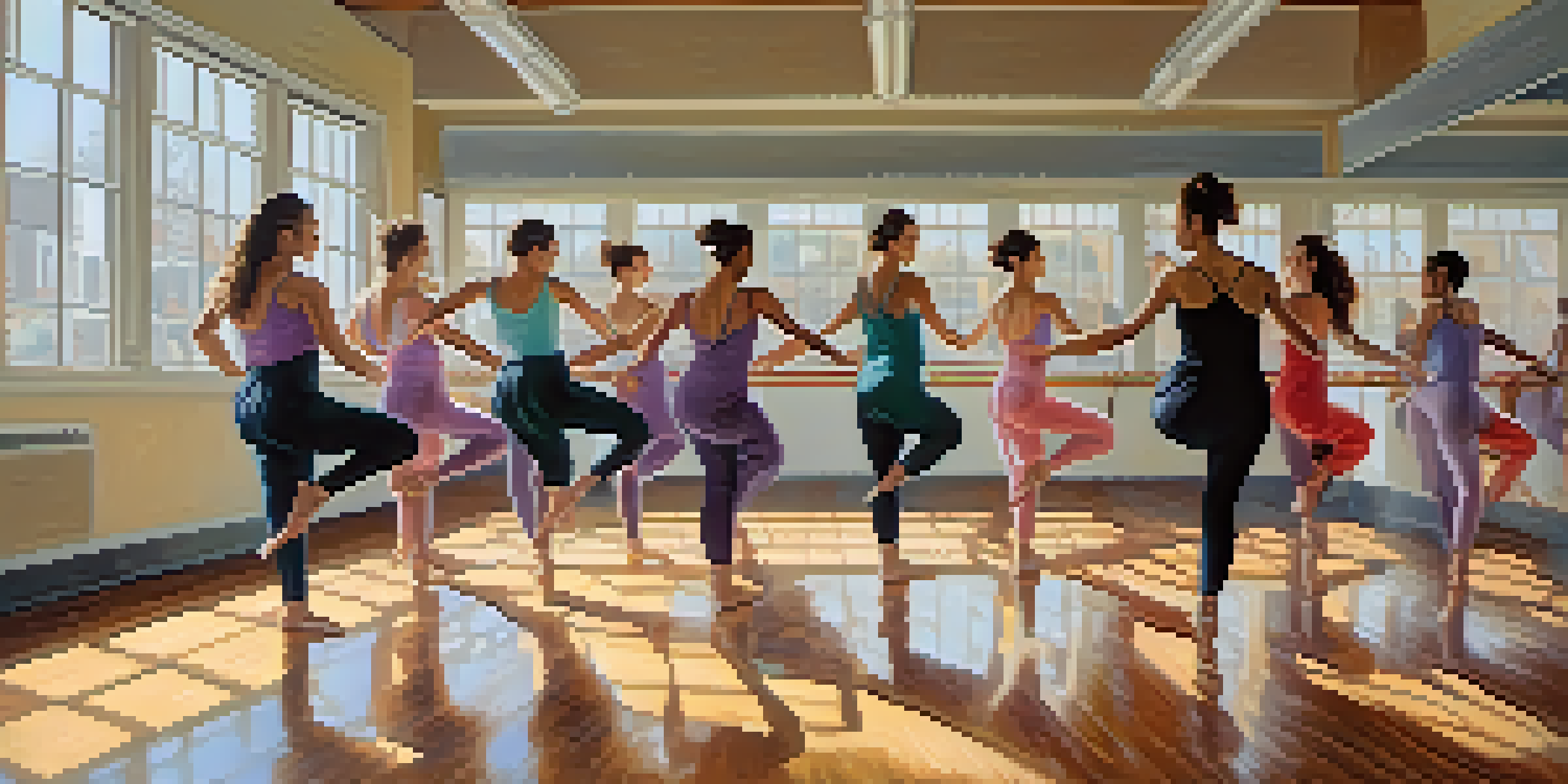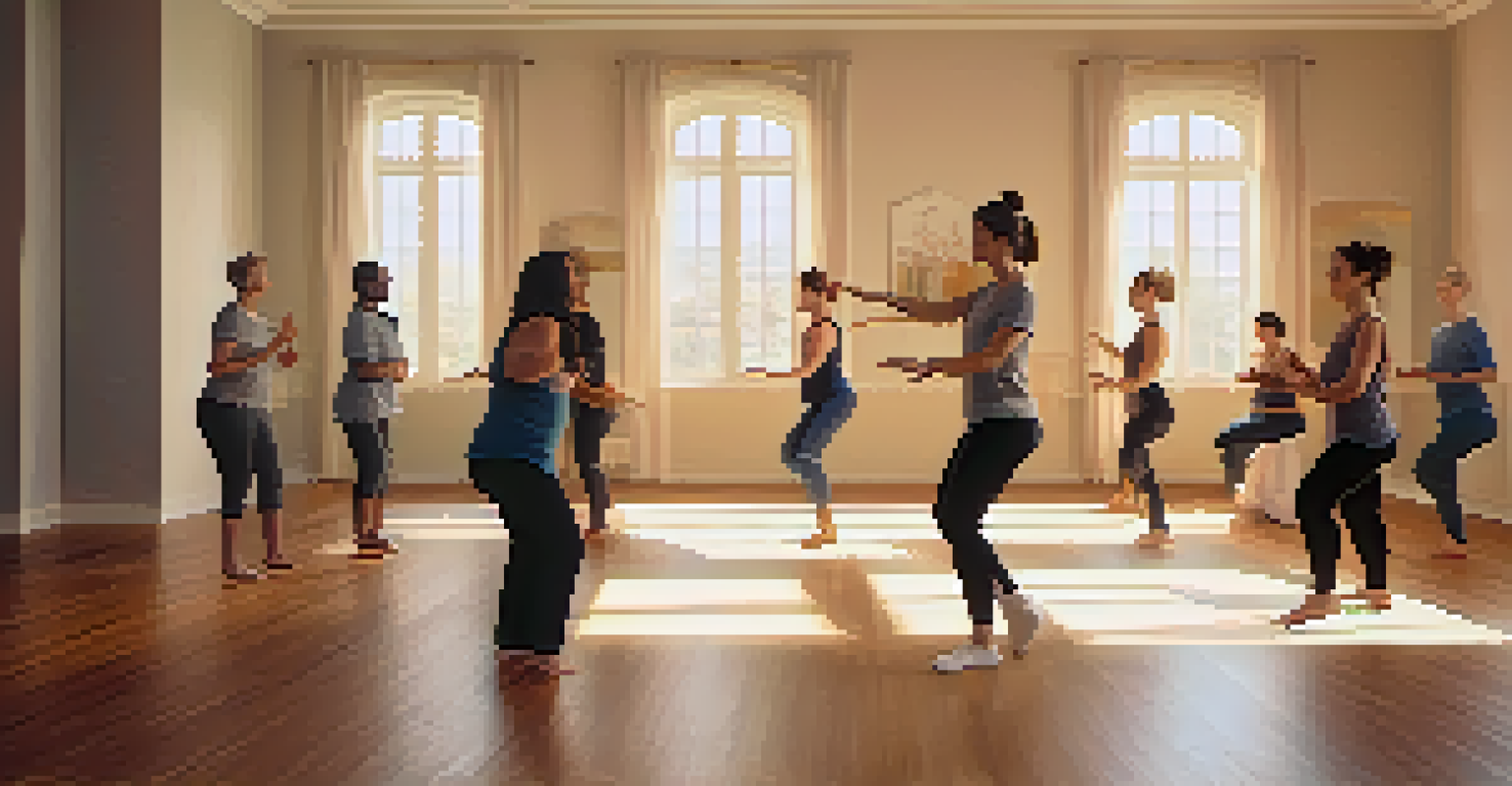The Healing Power of Dance: Emotional Release Through Movement

Understanding Dance as a Form of Expression
Dance has long been recognized as a universal language that transcends barriers. It allows individuals to communicate emotions that words sometimes fail to express. When we move, we tap into a deeper part of ourselves, revealing feelings that may be buried beneath the surface.
Dance is the hidden language of the soul.
For example, consider how a joyful dance can embody happiness and celebration, while a slower, more fluid movement may express sorrow or longing. This ability to convey emotions through movement fosters a sense of connection not only with oneself but also with others who witness or participate in the dance.
Ultimately, dance becomes a form of storytelling, where each step, twist, and turn tells a tale of its own. It provides a safe space for emotional exploration, enabling individuals to process their feelings in an engaging and dynamic way.
The Science Behind Dance and Emotional Well-Being
Research indicates that dance can significantly enhance emotional well-being. Engaging in physical activity releases endorphins, known as 'feel-good' hormones, which can elevate mood and reduce stress. This biochemical reaction is just one of the many ways dance can foster emotional healing.

Moreover, studies have shown that dance therapy can lead to improved mental health outcomes for individuals dealing with anxiety, depression, and PTSD. In group settings, dance promotes social interaction, reducing feelings of isolation and loneliness, further enhancing emotional resilience.
Dance as Emotional Expression
Dance serves as a universal language, allowing individuals to communicate emotions that words often cannot.
The combination of physical movement and emotional expression creates a powerful therapeutic tool. It’s a holistic approach that nurtures both body and mind, making dance a unique avenue for emotional release and healing.
Dance as a Tool for Stress Relief
Life can often feel overwhelming, and finding effective stress relief methods is crucial. Dance offers a fun and engaging way to let off steam and release pent-up emotions. Whether it's a spontaneous dance session in your living room or a structured class, the act of dancing can serve as an escape from daily pressures.
Dance is the joy of movement and the heart of life.
When you dance, you are fully present in the moment, which can be a form of mindfulness. This focus on movement and rhythm can help distract from stressors, allowing your mind to reset and recharge. It’s an opportunity to shake off tension and reconnect with your body.
As you immerse yourself in the music and movement, you may find that stress begins to melt away. The freedom of expression dance provides can lead to a lighter heart and a clearer mind, making it an effective stress-relief strategy.
Releasing Emotions Through Movement
Dance allows for the physical release of emotions that may be difficult to articulate. When we move our bodies, we can process feelings like anger, sadness, or joy without needing to explain them. This physical outlet can be incredibly cathartic, providing a sense of relief and liberation.
For instance, consider how a vigorous dance can help channel frustration into movement, transforming that energy into something creative and positive. Alternatively, gentle movements can help soothe anxiety and promote calmness, allowing for introspective emotional exploration.
Healing Through Movement
Engaging in dance can enhance emotional well-being by releasing stress and promoting feelings of happiness.
Ultimately, the act of moving can serve as a powerful reminder that emotions are meant to be felt and expressed. Through dance, we learn to embrace our feelings, leading to a healthier emotional state.
Cultural Significance of Dance in Emotional Healing
Throughout history, dance has played an integral role in various cultures as a means of emotional expression and healing. Many indigenous cultures incorporate dance in rituals to celebrate, mourn, or heal, showcasing its deep-rooted significance in human connection.
These cultural practices illustrate how dance can serve not only individual healing but also community bonding. By participating in group dances, people can share their experiences and emotions, fostering a sense of solidarity and support.
As we embrace diverse dance traditions, we can appreciate the ways in which movement has been used to heal emotional wounds across generations. This cultural richness adds depth to our understanding of dance as a therapeutic practice.
Dance Therapy: Professional Guidance for Emotional Healing
For those seeking a more structured approach, dance therapy offers a professional avenue for emotional healing. Certified dance therapists use movement to facilitate emotional expression, encourage self-discovery, and promote personal growth. This therapeutic practice is rooted in the belief that the body and mind are interconnected.
During dance therapy sessions, participants engage in movement activities designed to explore feelings and improve emotional health. It’s a safe space where individuals can express themselves without judgment, guided by a trained professional who understands the nuances of emotional release through movement.
Cultural Role of Dance in Healing
Throughout history, dance has been integral to various cultures as a means of emotional expression and community bonding.
Dance therapy can be particularly beneficial for individuals who may struggle with traditional talk therapy. By integrating movement and creativity, participants often find new pathways to understanding and healing.
How to Incorporate Dance into Your Life for Healing
Incorporating dance into your daily routine can be a simple yet effective way to promote emotional healing. Start small—put on your favorite music and allow yourself to move freely without any expectations. This spontaneous expression can help you connect with your feelings and release any pent-up emotions.
Consider joining a dance class or community group where you can learn new styles and meet like-minded individuals. The social aspect of group dancing can enhance your emotional experience, providing a sense of belonging and support.

Lastly, remember that there’s no right or wrong way to dance. Embrace your unique style and use movement as a personal outlet for emotional exploration. By making dance a regular part of your life, you can cultivate a deeper understanding of yourself and your emotions.